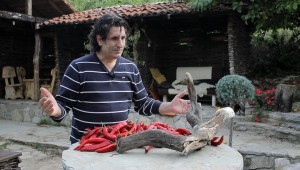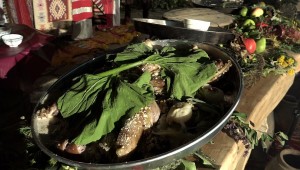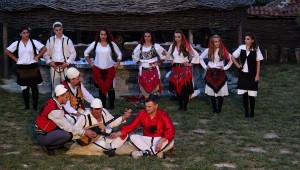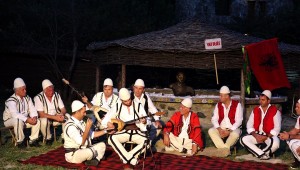We might not know with certainty what Illyrians did throughout history due to a lack of written evidence, but now we at least can learn about their diet, their scientific endeavors, and what they discussed – all at Kosovo’s Etno Fest.
In the village Kukaj, a tiny speck in Prishtina’s vicinity, a four-day festival called Etno Fest has begun. On the evening of September 14, the opening ceremony of the sixth edition of the ethnic Albanian festival was held. The festival promotes Albanian customs by bringing together a mix of Albanian customs in modern times, and moreover, an insight into Illyrian traditions.
In one of the open-air galleries of the beautiful, scenic complex called ‘Etno Village,’ sculptures with the motif of the Godess on the Throne–the Queen of Dardania–were on display as part of Arjeta Miftari’s exhibition “Goddesses in Kukaj.”
Yet references to the Illyrians, the scientifically unconfirmed ancestors of Albanians, did not stop there. To the surprise of many, a wooden table covered with different herbs stood under the shade of a local pear tree. The display, organized by the Kosovo Museum, was named “The Magic of the Illyrian Cuisine.”
Before the herbs were cooked in the hearth made from pieces of wood and industrial slates, a documentary titled The Magic of the Illyrian Culinary, which was financed by the Albanian Culture Ministry, was screened (the film was unfortunately cut short when the wi-fi failed in the ancient-looking village).
The main character of the documentary was Ahmet Dursun, a connoisseur of Egyptian and Ancient Greek cuisine, and apparently also of Illyrian gastronomy – as Fadil Hysaj, the director of the festival and a famous producer, introduced him.
The documentary showed beautiful scenery of Albanian mountains, green valleys, riverbeds and landscapes that many countries would envy – but the narrator told the tales as if recounting scientific facts.
In the film, Ahmet Dursun, who was present in Etno Fest (where he also performed), is seen squatting on a certain nondescriptive spot and tells the viewers, “two Illyrian tribes would meet here every autumn and discuss which mountain was more beautiful.”

Ahmet Dursun talks about Illyian cuisine, in front of a pile of red peppers, which were incidentally brought to Europe from the Americas. | Photo: BIRN.
Such claims of deeply detailed knowledge about Illyrians, despite the lack of historical evidence, are not unusual in various events of nationalist character.
Even though he may not have convinced the audience, Dursun had convinced the director of the Kosovo Museum, Skender Boshtrakaj.
Boshtrakaj took the stage and shared with the the public how one time, Dursun prepared lamb in the Illyrian tradition. “When I took the lid off the dish in which the lamb was cooking, I could smell the grass that the lamb had been fed,” said Boshtrakaj, who shared his wish that everyone have such a “magical” opportunity.
Director Boshtrakaj’s amazement with the Illyrian cuisine connoisseur Dursun was comparable to the scene in the Asterix cartoon when the magician Getafix prepares some sort of soup for the Gauls to beat the Romans.

Illyrian lamb with pumpkin leaves,made by Dursun during Etno Fest. | Photo: BIRN.
Does the Illyrian myth come from the magical Illyrian cuisine, à la Getafix?
Or perhaps it even echoes later Albanian myths (similar to epic poetry in other Balkan countries as well) in which milk of the fairies can give great powers to the frontier warriors (kreshniket), who can then unroot trees, move gigantic rocks or decapitate people – often without a good reason.
But Illyrians were not only great cooks apparently. Suhel Ahmeti from the Astronomy Club of Kosovo, who had brought a few telescopes to view the stars, the moon, and the sun, explained why his own club was there.
“Astronomy isn’t only a science but it’s culture as well,” he told me, adding that astronomy was one of the earliest human activites. “Illyrians did astronomy.”
“According to NASA, the first ancient observatory existed at a high point in Kumanova [now Macedonia, formerly presumably Illyrian],” he said.
A group of young people wearing national costume performed. Ethnology professor Uke Xhemaj woefully complained about the problems one can encounter with such dress in performances.
For example, whether you tie the scarf around your head, under your chin, or at the nape shows a girl’s marital status. “They [the performers] don’t give much thought to these details, except when they have a choreographer who can pay attention to details,” said professor Xhemaj.
Nevertheless, he was optimistic that despite such little problems, things would be perfected in time.

Folk ensembles from different Albanian-inhabited territories participated in the festival. | Photo: BIRN.
Meanwhile, historian Shkelzen Gashi, who has studied history textbooks in Kosovo and in the neighboring countries, said that no sufficient evidence exists for the hypothesis that Albanians are descendants of Illyrians.
“There might be indicators of a continuity from Illyrians to Albanians, but sufficient evidence for conclusions are lacking,” said Gashi, referring to other historians, explaining the inability to determine ancestry correctly.
“As Noel Malcom rightfully says, ancestry becomes mysterious if we look deep into the past because a population always comes from another and someone came first, but that is not a valid argument when deciding about the right and wrongs of today’s political situation,” he explained, adding that, “The ancestry of all people is mixed and we cannot assume that all of our ancestors were of the same population.”
Especially in the Balkans, an arena of century-long conquests and demographic fluctuations, “racial purity” – a racist concept in itself – can hardly be ensured.
Along with fantastic Illyrian myths, the Etno Fest program, which ends on Saturday, will include documentary screenings, theatre shows, Albanian artistic performances, music, dance, and many other activities.
Furthermore, visitors can treat themselves to local food and, with a little bit of luck, can try Illyrian dishes during Durun’s performance. All of this surrounded by the beautiful lush nature and the private Etno Village complex.

Bards singing epic songs during Etno Fest. | Photo: BIRN
The investments into the Etno Village complex and the construction of a new road initaited many other home constructions in order to repopulate a village that was formerly abandoned, yet is now embraced by the Illyrian breeze.
Kukaj is not the only place to be affected by such an ancient breeze. Visoko Hill in Bosnia and Herzegovina, north-west of the capital Sarajevo, is “the cradle of Bosnian pyramids.” A few years ago, archaeologist Semir Osmanagic claimed he discovered the largest pyramid ever.
A portion of the Montenegrin people who do not identify as Serbs consider themselves “slavicized Illyrians” – an autochtonous invention that you can hear in places ranging from cevabdzinica to sophisticated academic dinner tables.
In the fantastic realm of historical fabrication, nothing is extraordinary. The Balkans is itself the embodiment of such myths that have been produced at an industrial scale for a while now.
Quite often in the Balkans, when things do not go well with historical evidence, new evidence is established. A similar ancient breeze blew over Prishtina’s neighboring capital, Skopje.
While Skopje 2014, among others, represents the baroque rebirth of an ‘ancient capital,’ at least Kukaj and Visoko Hill are only suburbs of the two respective capital cities.





